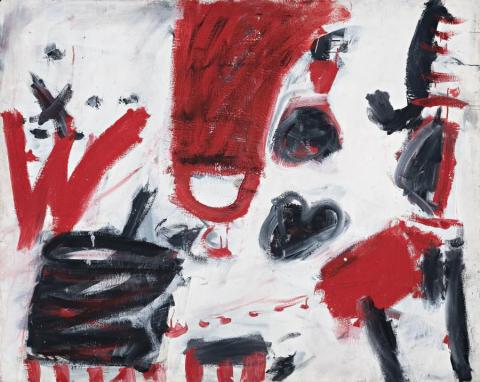BIG RED W, c.1964
TONY TUCKSON
oil on composition board
121.5 x 152.0 cm
Pinacotheca, Melbourne
Private collection, Sydney
Deutscher~Menzies, Melbourne, 2 September 2003, lot 26
Private collection, Melbourne
Tony Tuckson 1921 - 1973: A Memorial Exhibition, Pinacotheca, Melbourne, 13 - 30 October 1982, cat.77 (illus.)
A Selection of Important Twentieth Century Australian and New Zealand Paintings, Martin Browne Fine Art, Sydney, 23 August - 10 September 2000, cat.3 (illus.)
Tony Tuckson 1921 - 1973, Watters Gallery & Margaret Tuckson, Sydney, 1982, p.44, cat.77 (illus.)
Betraying a myriad of artistic influences from Turner, Picasso, Klee and Pollock to fellow Australian painter Ian Fairweather, Tuckson's oeuvre is rich in its diversity, encompassing many different painterly approaches and phases. With its bold palette and dramatic gestural brushwork, the present work Big Red W, c.1964, belongs to the period generically known as the 'Red, Black and White' paintings. Revealing a keen awareness of American abstract expressionism and pop art, this chapter of Tuckson's production (broadly dated from 1961 to 1965) opened with elaborately worked imagery employing collage elements and obvious narrative, gradually progressing to bold minimalist compositions. Interestingly, Daniel Thomas parallels this shift in Tuckson's style from the elegant, painterly works of the fifties which employed poetic graffiti marks and a more subdued palette, to the change in emphasis of collecting practices at the Art Gallery of New South Wales where the artist was Deputy Director and Curator - the progression from Aboriginal to Melanesian art signaling 'a change from fine delicate art to art which can be coarse and bold.'1
With the 'Red, Black and White' paintings acclaimed amongst his finest (and toughest) works, Big Red W thus encapsulates well Tuckson's highly personal and expressive language of signs and symbols articulated through the written mark and textural layering of paint. More broadly, the work attests to the artist's lifelong preoccupation with the very act of painting itself; as James Gleeson reflects,
'...His pictures are about what it feels like to paint a picture - and as Tuckson feels it, a large part of it is agony. Making a picture or indeed any kind of art is a kind of birth. There is labour involved... Tuckson isn't interested in the art that conceals effort. He shows the making of a painting with all the travail fully exposed, without prettification or pretence that it hasn't hurt... In the end he triumphs because he does communicate his urgency through the painting. The pictures become a point of contact. The viewer who takes the risk of opening himself to these works will be rewarded by a rare glimpse of the emotional and physical costs of creativity.'2
1. Thomas, D. et al., Tony Tuckson, Craftsman House, Sydney, 1989, pp.34-35.
2. Gleeson, J., 'The Travail of Painting', Sun-Herald, 22 April 1973
VERONICA ANGELATOS
